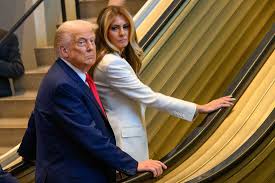“Triple Sabotage” or Technical Failures? Trump Blames UN for Glitches During General Assembly Speech
The United Nations General Assembly is usually a showcase of diplomacy, polished speeches, and global theater. But Donald Trump says his recent appearance there was anything but routine. What began as a presidential arrival soon became a series of public embarrassments:
a stalled escalator, a blank teleprompter, and alleged audio issues. Trump now insists these weren’t mere mishaps but calculated attempts to humiliate him on the world stage—with what he calls “triple sabotage.”
Trump’s Claims: Sabotage in Three Acts
In a social media post and public remarks, Trump laid out the sequence:
Escalator Malfunction
As he and former First Lady Melania Trump ascended on an escalator at the U.N. building, it abruptly stopped. Videos show them stepping off and continuing by foot. Trump later claimed the stoppage was deliberate and nearly caused them to “fall face‑first.” He demanded that whoever was responsible be arrested and announced that the Secret Service is investigating.

Teleprompter Failure
Trump said his teleprompter darkened during the opening remarks, forcing him to speak without prepared cues. He later quipped that whoever was operating it “is in big trouble.”
Audio Problems
Trump maintains that the sound system in the hall failed, meaning delegates couldn’t hear his speech unless they used interpreter earpieces. He called this “completely off” and cited it as another dimension of intentional sabotage.
In his public posts, Trump framed these events as coordinated—and not coincidental. He called on the U.N. to preserve camera footage and demanded a full investigation.
The U.N. Response and Alternative Explanations
The United Nations pushed back quickly and offered alternative explanations for the incidents:
Escalator Safety System Triggered
U.N. officials say the escalator’s built‑in safety mechanism was triggered after a U.S. delegation videographer walked ahead of Trump, potentially activating a sensor meant to prevent objects from being caught. The U.N. conveyed that this safety feature is designed to shut down the mechanism under certain conditions.
Teleprompter Operated by Trump’s Team
U.N. representatives have clarified that the teleprompter system used during Trump’s speech was under the control of the White House/Trump’s staff—not U.N. staff. This places responsibility, in their view, closer to Trump’s own team.
Audio Functionality Intact
While Trump claims delegates couldn’t hear him, the U.N. notes that its system is built to transmit translated speech via interpreter earpieces. There is, as of now, no independent confirmation that the main hall audio system failed outright.
What We Know—and What Remains Unclear
Evidence is mixed. Some incidents (like the escalator halt) are confirmed by video. But whether the teleprompter failure or audio problems were intentional—or even fully malfunctioning—remains disputed.
Responsibility is contested. Trump points at the U.N. as the culprit; the U.N. points at safety systems and White House control.
The involvement of the Secret Service is now confirmed, at least in reviewing the escalator stoppage as a potential security concern.
Reuters
Public and media reaction has ranged from support for Trump’s demands for accountability to skepticism about whether the glitches amount to sabotage or simply a series of mishaps.
Conclusion
Donald Trump has framed the stalled escalator, teleprompter blackout, and claimed audio failure not as technical blips but as a coordinated effort to undermine him. The U.N. insists the incidents are either due to safety mechanisms or technical control outside its purview. Whether a full investigation will validate Trump’s claims or instead confirm a string of mechanical malfunctions is yet to be determined.
What is clear: these disruptions now carry meaning far beyond mechanics—they are part of a broader battle over narrative, credibility, and power on the world stage.
